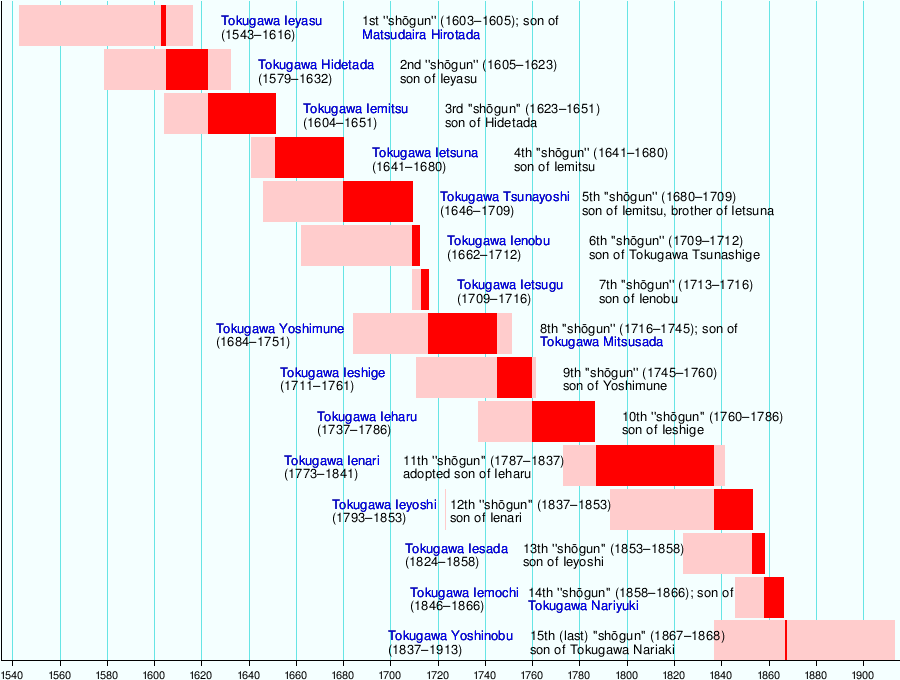Tokugawa Ienari
Tokugawa Ienari | |
|---|---|
 | |
| 11th Edo Shogun | |
| In office 1787–1837 | |
| Preceded by | Tokugawa Ieharu |
| Succeeded by | Tokugawa Ieyoshi |
| Personal details | |
| Born | November 18, 1773 |
| Died | March 22, 1841 (aged 67) |
Tokugawa Ienari; 徳川 家斉 (November 18, 1773 – March 22, 1841) was the eleventh and longest-serving shogun of the Tokugawa shogunate of Japan who held office from 1787 to 1837.[1] He was a great-grandson of the eighth shogun Tokugawa Yoshimune through his son Munetada (1721–1764), head of the Hitotsubashi branch of the family, and his grandson Harusada (1751–1827).
Family life
First wife
In 1778, the four-year-old Hitotsubashi Toyochiyo, a minor figure in the Tokugawa clan hierarchy, was betrothed to Shimazu no Shige-hime[2] or Tadako-hime, the four-year-old daughter of Shimazu Shigehide, the tozama daimyo of Satsuma Domain on the island of Kyūshū. The significance of this alliance was dramatically enhanced when, in 1781, the young Toyochiyo was adopted by the childless shogun, Tokugawa Ieharu. This meant that when Toyochiyo became Shogun Ienari in 1786, Shigehide was set to become the father-in-law of the shogun.[3] The marriage was completed in 1789, after which Tadako became formally known as Midaidokoro Sadako, or "first wife" Sadako. Protocol required that she be adopted into a court family, and the Konoe family agreed to take her in but this was a mere formality.[4]
Other relationships
Ienari was known as a degenerate who kept a harem of 900 women and fathered over 75 children[citation needed]
Many of Ienari's myriad children were adopted into various daimyo houses throughout Japan, and some played important roles in the history of the Bakumatsu and Boshin War. Some of the more famous among them included:
- Hachisuka Narihiro,Tokushima Domain
- Matsudaira Naritami,Tsuyama Domain
- Tokugawa Narikatsu,Shimizu-Tokugawa family then to Wakayama Domain
- Matsudaira Narisawa,Fukui Domain
- Tokugawa Nariyuki,Wakayama Domain
Events of Ienari's bakufu
- 1787 (Tenmei 7): Ienari becomes the 11th shogun of the bakufu government.[1]
- 1788 (Tenmei 7): Riots in rice shops in Edo and Osaka.
- March 6–11, 1788 (Tenmei 8, 29th day of the 1st month–4th day of the second month): Great Fire of Kyoto. A fire in the city, which begins at 3 o'clock in the morning of March 6 burns uncontrolled until the 1st day of the second month (March 8); and embers smolder until extinguished by heavy rain on the 4th day of the second month (March 11). The emperor and his court flee the fire, and the Imperial Palace is destroyed. No other re-construction is permitted until a new palace is completed. This fire was considered a major event. The Dutch VOC Opperhoofd in Dejima noted in his official record book that "people are considering it to be a great and extraordinary heavenly portent."[5]
- February 28, 1793 (Kansei 5, on the 18th day of the 1st month): Collapse of the peak of Mt. Unzen.[6]
- March 17, 1793 (Kansei 5, on the 6th day of the 2nd month): Eruption of Mt. Biwas-no-kubi[6]
- April 15, 1793 (Kansei 5, on the 1st day of the 3rd month): The Shimabara earthquake.[7]
- May 10, 1793 (Kansei 5, on the 1st day of the 4th month): Eruption of Mt. Miyama.[6]
- September 1817, the Shogun orders the expulsion of Titia Bergsma, the first European woman to visit Japan
- 1833–1837, the Tenpo famine
- 1837 (Tenpō 7): Tokugawa Ieyoshi becomes the 12th shogun of the bakufu government.[1]
His time in office was marked by an era of pleasure, excess, and corruption, which ended in the disastrous Tenpō Famine of 1832-1837, in which thousands are known to have perished.
Eras of Ienari's bakufu
The years in which Ienari was shogun are more specifically identified by more than one era name or nengō.[8]
- Tenmei (1781–1789)
- Kansei (1789–1801)
- Kyōwa (1801–1804)
- Bunka (1804–1818)
- Bunsei (1818–1830)
- Tenpō (1830–1844)
See also
Notes
- ^ a b c Hall, John Whitney et al. (1991). Early Modern Japan, p. 21.
- ^ Screech, Timon. (2006). Secret Memoirs of the Shoguns: Isaac Titsingh and Japan, 1779–1822, p. 234 n12.
- ^ Screech, p. 11.
- ^ Screech, p. 221 n35.
- ^ Screech, pp. 152–154, 249–250
- ^ a b c Screech, p.154.
- ^ Screech, p. 155.
- ^ Titsingh, Isaac. (1834). Annales des empereurs du japon, p. 420.
References
- Hall, John Whitney and Marius Jansen. (1991). Early Modern Japan: The Cambridge History of Japan. Cambridge: Cambridge University Press. ISBN 978-0-521-22355-3; OCLC 62064695
- Screech, Timon. (2006). Secret Memoirs of the Shoguns: Isaac Titsingh and Japan, 1779-1822. London: RoutledgeCurzon. ISBN 0-7007-1720-X
- Titsingh, Isaac. (1834). Nihon Ōdai Ichiran; ou, Annales des empereurs du Japon. Paris: Royal Asiatic Society, Oriental Translation Fund of Great Britain and Ireland. OCLC 5850691.
- Totman, Conrad. (1967). Politics in the Tokugawa bakufu, 1600–1843. Cambridge: Harvard University Press.

